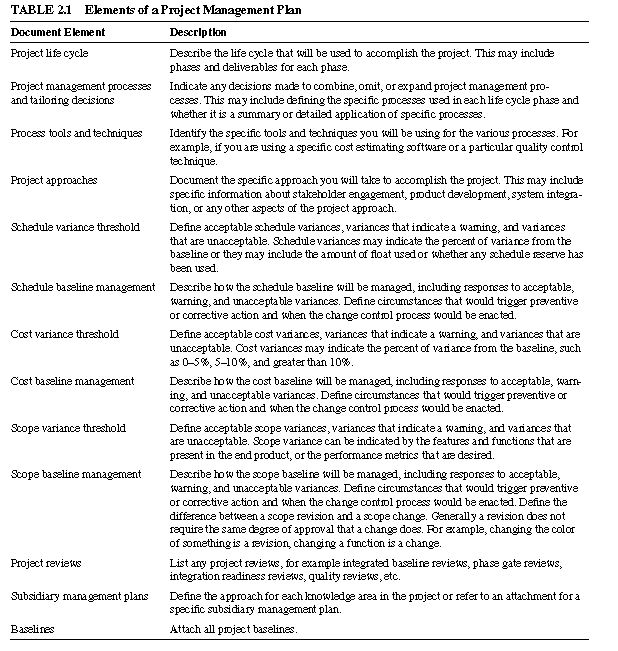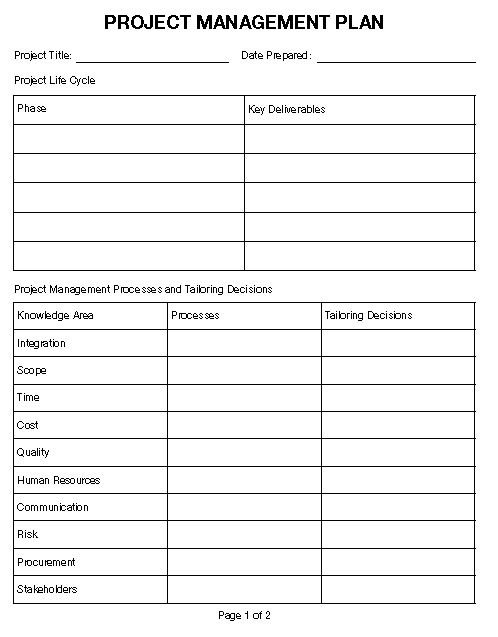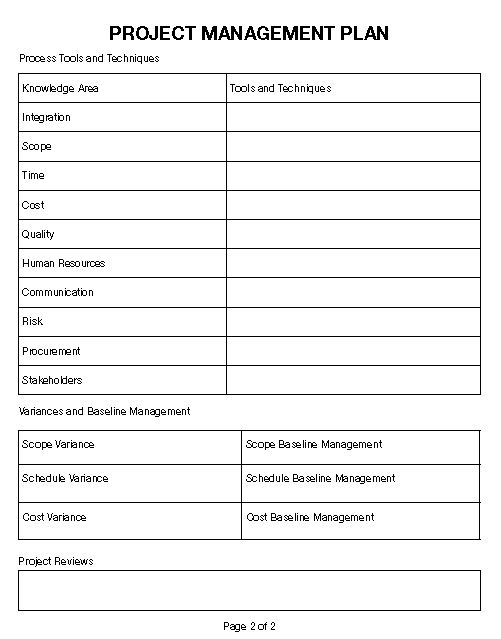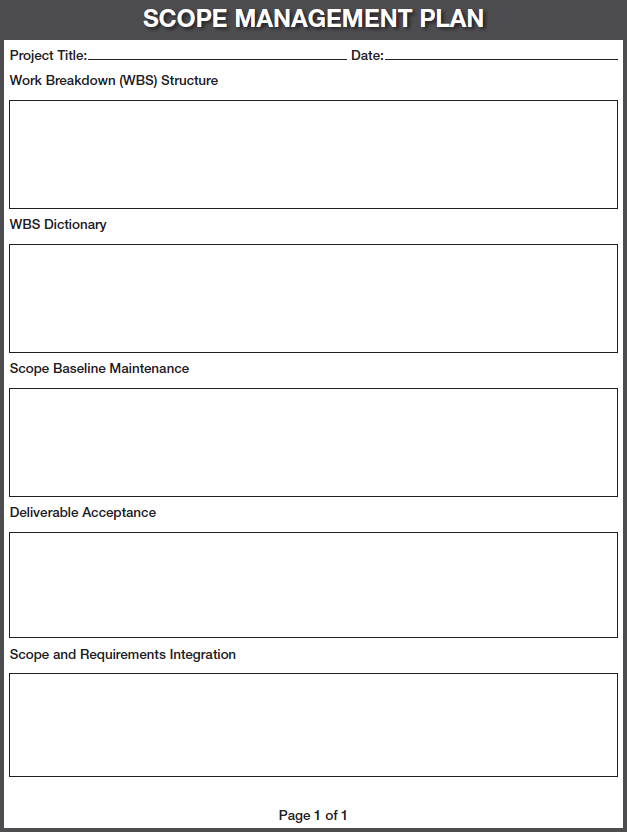


2.0 PLANNING PROCESS GROUP The purpose of the planning process group is to elaborate the information from the project charter to create a comprehensive set of plans that will enable the project team to deliver the project objectives. There are 24 processes in the planning process group.
• Develop Project Management Plan
• Plan Scope Management
• Collect Requirements
• Defi ne Scope
• Create WBS
• Plan Schedule Management
• Defi ne Activities
• Sequence Activities
• Estimate Activity Resources
• Estimate Activity Durations
• Develop Schedule
• Plan Cost Management
• Estimate Costs
• Determine Budget
• Plan Quality Management
• Plan Human Resource Management
• Plan Communications Management
• Plan Risk Management
• Identify Risks
• Perform Qualitative Analysis
• Perform Quantitative Analysis
• Plan Risk Responses
• Plan Procurement Management
• Plan Stakeholder Management
The intent of the planning process group is to at least:
• Elaborate and clarify the project scope
• Develop a realistic schedule
• Develop a realistic budget
• Identify project and product quality processes
• Plan the human resource aspects of the project
• Determine the communication needs
• Establish risk management practices
• Identify the procurement needs of the project
• Determine how to manage stakeholder engagement
• Combine all the planning information into a project management plan and a set of project documents that are cohesive and integrated
Planning is not a one-time event. It occurs throughout the project. Initial plans will become more detailed as additional information about the project becomes available. Additionally, as changes are approved for the project or product, many of the planning processes will need to be revisited and the documents revised and updated. Many of the forms in this section provide information needed for other forms. The form description indicates from where information is received and to where it goes.
The forms used to document planning information include:
• Project Management Plan
• Scope Management Plan
• Requirements Management Plan
• Requirements Documentation
• Requirements Traceability Matrix
• Project Scope Statement
• Assumption and Constraint Log
• Work Breakdown Structure
• Work Breakdown Structure Dictionary
• Schedule Management Plan
• Activity List
• Activity Attributes
• Milestone List
• Network Diagram
• Activity Resource Requirements
• Resource Breakdown Structure
• Activity Duration Estimates
• Duration Estimating Worksheet
• Project Schedule
• Cost Management Plan
• Activity Cost Estimates
• Cost Estimating Worksheet
• Bottom-Up Cost Estimating Worksheet
• Cost Baseline
• Quality Management Plan
• Quality Metrics
• Process Improvement Plan
• Responsibility Assignment Matrix
• Roles and Responsibilities
• Human Resource Management Plan
• Communications Management Plan
• Risk Management Plan
• Risk Register
• Probability and Impact Assessment
• Probability and Impact Matrix
• Risk Data Sheet
• Procurement Management Plan
• Source Selection Criteria
• Change Management Plan
• Stakeholder Management Plan
Some forms in this section are not explicitly described in the PMBOK® Guide, but they are useful in planning and managing a project. Use the forms here as a starting point for your project. You should tailor the forms to meet the needs of your project by editing, combining, or revising them.
2.1 PROJECT MANAGEMENT PLAN The project management plan describes how the team will execute, monitor, control, and close the project. While it has some unique information, it is primarily comprised of all the subsidiary management plans and the baselines. The project management plan combines all this information into a cohesive and integrated approach to managing the project. Typical information includes:
• Selected project life cycle
• Processes used to manage the project and information on how they have been tailored
• Tools and techniques that will be used in the project management processes
• Specifi c approaches to meet project objectives
• Variance thresholds
• Baseline management
• Timing and types of reviews
The project management plan contains plans for managing all the other knowledge areas as well as other specific aspects of the project. These take the form of subsidiary management plans and can include:
• Scope Management Plan
• Schedule Management Plan
• Requirements Management Plan
• Cost Management Plan
• Quality Management Plan
• Human Resources Management Plan
• Communications Management Plan
• Risk Management Plan
• Procurement Management Plan
• Stakeholder Management Plan
• Change Management Plan
• Configuration Management Plan
• Process Improvement Plan
The project management plan also contains baselines. Common baselines include:
• Scope baseline
• Schedule baseline
• Cost baseline
In addition, any other relevant, project-specifi c information that will be used to manage the project is recorded in the project management plan. The project management plan can receive information from all the subsidiary management plans and baselines. Because it is the foundational document for managing the project it also provides information to all subsidiary plans. In addition, the project management plan provides information to all other integration processes and the work performance information from all the control processes. You can use the element descriptions in Table 2.1 to assist you in developing a project management plan. 


2.2 SCOPE MANAGEMENT PLAN The Scope Management Plan is part of the project management plan. It specifi es how the project scope will be defined, developed, monitored, controlled, and validated. Planning how to manage scope should include at least processes for:
• Developing a detailed scope statement
• Decomposing the project into discrete deliverables using a WBS
• Determining what constitutes a scope change versus a revision and how scope changes will be managed through the formal change control process
• Maintaining the WBS and the scope baseline
• How deliverables will be accepted
In addition, the Scope Management Plan may provide direction on the elements that should be contained in a WBS Dictionary and how the scope and requirements management plans interact. The Scope Management Plan can receive information from:
• Project Charter
• Project Management Plan It is related to:
• Requirements Management Plan It provides information to:
• Requirements Documentation
• Scope Statement
• WBS
• WBS Dictionary
The Scope Management Plan is an output from the process 5.1 Plan Scope Management in the PMBOK® Guide—Fifth Edition. You can use the element descriptions in Table 2.2 to assist you in developing a Scope Management Plan.
Tailoring Tips
Consider the following tips to help tailor the scope management plan to meet your needs:
• For smaller projects you can combine the scope management plan with the requirements managementplan.
• For larger projects consider a test and evaluation plan that defines how deliverables will be validatedand accepted by the customer.
• If your project involves business analysis you may want to incorporate information on how businessanalysis activities and project management activities will interact.
• If you are using an agile or adaptive development approach you may want to incorporate informationon the release and iteration plans.
Alignment
The scope management plan should be aligned and consistent with the following documents:
• Development approach
• Life cycle description
• Change management plan
• Requirements management plan
• Release and iteration plan
Description
You can use the descriptions in Table 2.3 to assist you in developing a scope management plan.
Table 2.3 Elements of the Scope Management Plan
Document Element Description
WBS Describe the WBS and whether it will be arranged using phases, geography,
majordeliverables, or some other way. The guidelines for establishing control
accountsand work packages can also be documented in this section.
WBS Dictionary Identify the information that will be documented in the WBS Dictionary and
the level of detail required.
Scope baseline maintenance Identify the types of scope changes that will need to go through the formal
changecontrol process and how the scope baseline will be maintained.
Deliverable acceptance For each deliverable, identify how the deliverable will be validated for
customer acceptance, including any tests or documentation needed for
sign-off.
Scope and requirements Describe how project and product requirements will be addressed in the scope
integration statement and WBS. Identify the integration points and how requirements and
scope validation will occur.
Project management and Describe how business analysis and project management will integrate
business analysis integration as scope is being defined, developed, tested, validated, and turned
over to operations.

2.5 Requirements Management Plan
The requirements management plan is part of the project management plan. It specifies how requirementsactivities will be conducted throughout the project.
Managing requirements activities includes at least:
• Planning activities such as:
○○ Collecting/eliciting
○○ Analyzing
○○ Categorizing
○○ Prioritizing○○ Documenting
○○ Determining metrics
○○ Defining the traceability structure
• Managing activities such as:
○○ Tracking
○○ Reporting
○○ Tracing○○ Validating
○○ Performing configuration management
The requirements management plan can receive information from:
• Project charter
• Development approach
• Quality management planIt is related to:
• Scope management planIt provides information to:
• Requirements documentation
• Requirements traceability matrix
• Quality management plan
• Risk register
The requirements management plan is an output from the process
5.1 Plan Scope Management in thePMBOK® Guide – Sixth Edition. It is developed once and does not usually change.
Tailoring Tips
Consider the following tips to help tailor the management plan to meet your needs:
• For smaller projects you can combine the requirements management plan with the scope managementplan.
• If your project involves business analysis, you may want to incorporate information on how businessanalysis requirements activities and project management requirements activities will interact.
• You can document the test and evaluation strategy in this plan. For larger projects you may want tohave a separate testing plan.
• If you are using an agile or adaptive development approach you may want to incorporate informationon how the backlog will be used to manage and track requirements.
Alignment
The requirements management plan should be aligned and consistent with the following documents:
• Development approach
• Change management plan
• Scope management plan
• Release and iteration plan
• Requirements backlogDescription
You can use the descriptions in Table 2.4 to assist you in developing a requirements management plan.T
Table 2.4 Elements of the Requirements Management Plan
Document Element Description
Requirements collection Describe how requirements will be collected or elicited. Consider techniques
such as brainstorming, interviewing, observation, etc.
Requirements analysis Describe how requirements will be analyzed for prioritization, categorization,
and impact to the product or project approach.
Requirements categories Identify categories for requirements such as business, stakeholder, quality, etc.
Requirements documentation Define how requirements will be documented. The format of a
requirements document may range from a simple spreadsheet to more
elaborate forms containingdetailed descriptions and attachments.
Requirements prioritization Identify the prioritization approach for requirements. Certain requirements will
be non-negotiable, such as those that are regulatory or those that are needed
to comply with the organization’s policies or infrastructure. Other requirements
may be nice to have, but not necessary for functionality
Requirements metrics Document the metrics that requirements will be measured against.
For example,if the requirement is that the product must be able to support 150 lb,
the metric may be that it is designed to support 120 percent (180 lb) and that any
design or engineering decisions that cause the product to go below the 120
percent need approval by the customer.
Requirements traceability Identify the information that will be used to link requirements from their origin
tothe deliverables that satisfy them.
Requirements tracking Describe how often and what techniques will be used to track progress
on requirements.
Requirements reporting Describe how reporting on requirements will be conducted and the frequency
of such reporting.
Requirements validation Identify the various methods that will be used to validate requirements such
asi nspection, audits, demonstration, testing, etc.
Requirements configuration Describe the configuration management system that will be used to control
management requirements, documentation, the change management process, and
the authorization levels needed to approve changes.